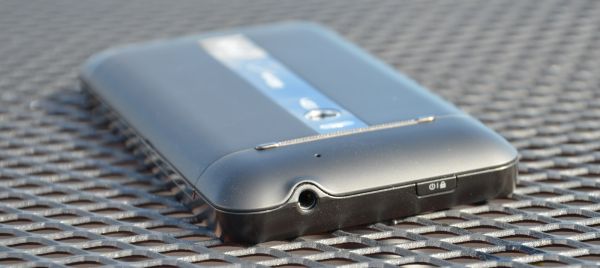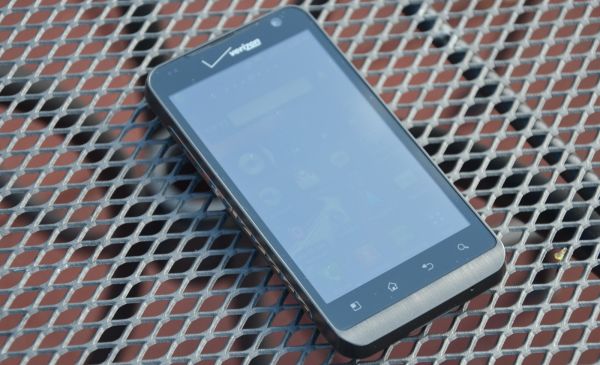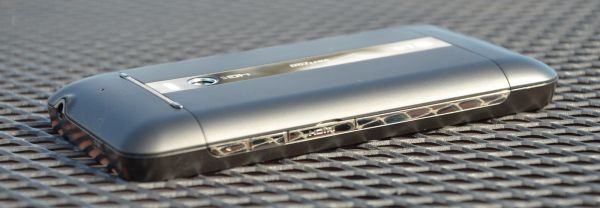LG Revolution: LTE for the Masses
by Vivek Gowri & Brian Klug on June 21, 2011 5:55 AM EST- Posted in
- Smartphones
- Verizon
- LTE
- Mobile
- LG Revolution
From the front, the Revolution looks similar to the other recent LG smartphones, namely the Optimus 2X and the Optimus Black. The screen panel is very slightly recessed into the front face, by roughly 0.1 or 0.3 millimeters, and houses the capacitive buttons and a front facing camera above the screen. The construction is entirely plastic, but the thin bezel has a brushed metal facade. For the life of me, I can’t comprehend why companies do this - why put a fake metal finish on it instead of just making it out of metal? With that said, it’s still a subtly attractive look.
The dark grey plastic continues through the rest of the body, separated by thin chrome bars on the side. The industrial designers would probably say they slice through the monotony of the grey, I say it just looks a bit tacky. The chrome bars contain a covered micro-USB port on the left side, and volume buttons and a covered micro-HDMI port on the right.

The top of the device has a small lock/power button and the headphone jack, right where God intended them to be (this is a huge peeve of mine with the HD7, iPod touch, and anything Samsung makes - bottom-mounted headphone jacks and side-located power buttons are stupid.)
The battery cover spans the entirety of the back side. It’s made of soft-touch black plastic, and has an attractive dark chrome strip going down the middle lengthwise. There are small clear windows at the top of the strip for the camera and flash, and the LG, Verizon, and LTE 4G logos below that. The speaker grille is also rendered in dark chrome. Overall, it’s a very understated and classy look that is relatively different from the rest of the smartphone market. In my opinion, the back is the best looking part of the Revolution, partially because the rest of it is so generic looking.
Overall, build quality is decent. It feels well built, though the material quality and the like cannot match Apple and HTC, who have been the industrial design leaders for some time now, in my mind at least. Granted, HTC sometimes makes some questionable decisions with regards to mechanical design (I’m looking at the G2 and the Surround), but they’re generally pretty good. Nothing against Samsung, LG, and Motorola, but their devices just aren’t in the same league as far as aesthetics or feel. The same is true for the Revolution, but the sheer size gives it a good, weighty in-hand feel, so it was more solid feeling than I expected.



















24 Comments
View All Comments
Spoogie - Tuesday, June 21, 2011 - link
In spite of the hype, I’m also turned off by 4G but for different reasons than battery life, though it is also an important consideration.When I purchased a 4G modem in January from Verizon, the connection was intermittent. And it would be down completely while searching for backup 3G… totally unacceptable. Verizon claimed that it should be a good connection based on the geography (Bay Area). Tech support was no help.
Recently I was in the market for a new phone, and while standing in the Verizon store admiring the Samsung Charge, low and behold the phone lost connectivity… while the 3G phones right next to it just hummed right along.
This led me to do some further investigating, and others report similar experiences, such as PhoneDog, who claims he has spotty performance with 4G in Philly and believes it isn’t ready for prime.
Although this doesn't exactly constitute a scientific study, I have no faith in it.
VivekGowri - Tuesday, June 21, 2011 - link
I don't know, I haven't tested LTE anywhere other than Seattle, but I've got coverage basically everywhere I've gone here. Once you head up into the northern parts of the area, to Everett and such, I've lost 4G, but the EVDO handover works pretty seamlessly. Signal strength was usually pretty good too, I was impressed.Impulses - Tuesday, June 21, 2011 - link
Sprint's Wimax may not boast LTE's impressive speeds across most markets, but at least you can seamlessly turn it off/on at the flick of a widget, right out of the box, which makes it easier to preserve battery life when you need to.I've got a question, do VZW LTE phones constantly poll the LTE radio even when outside of LTE markets or is there some software list that shuts them off completely outside LTE markets?
I'm particularly curious because PR isn't likely to have true 4G for a while, yet the carriers sell the very same phones here... Sprint has started testing Wimax in some areas (which is curious since this isn't a Clearwire market), but it seems they're still a long way off before any kind of solid announcement.
In the metro area they're literally just testing it on a handful of towers, and it isn't even on all the time... I guess it might be part of the procedure for their Vision deployment, even if there aren't any permanent 4G plans.
Impulses - Tuesday, June 21, 2011 - link
Oops, just saw you mentioned the same thing about Wimax on the article... I had only read the first and last page when I posted the comment. My question about how LTE is polled or detected on a stock phone still stands tho.I know you can disable it thru service menus and there's probably an app or two that can make that easier, but not everyone that buys these phones outside LTE markets is gonna go looking for those.
wintermute000 - Tuesday, June 21, 2011 - link
for now, good quality HSDPA+ is fine (Telstra user in Australia).Most modern droids can get theoretical 14M down, in practice being able to consistently pull down 1Mb+ almost anywhere, is good enough for anything but streaming. (I have to admit on some days, streaming podcasts cuts up a bit) but raw throughput is fine. '
I'd rather go dual core now and get the LTE phones in a year or two for that price
jonup - Tuesday, June 21, 2011 - link
Can we get these phones down to 100g? Everytime I pick up my coworkers' iPhones and Droids one thought comes to my mind "Why are you so fat when you hauling this brick all day"?vision33r - Tuesday, June 21, 2011 - link
Everytime I see a Thunderbolt user on the train, it's usually for a hotspot and then I see them busting out the blackberry for emails.Right now these LTE devices are only for IT pros that have the need for the speed and the companies paying for them.
They are like every new tech devices just the 1st to market but not ready for mainstream adoption until they fix the power consumption and size.
2nd gen to 3rd gen will replace 3G devices they will take 5 years to happen.
antef - Tuesday, June 21, 2011 - link
That speed is very impressive for a mobile broadband network but honestly who cares? No activity on your phone is going to make much use of anything beyond a few Mbps for things like streaming video. Can you provide a single instance where you'll notice 3 Mbps vs 18 Mbps except when running the Speed Test app? In addition to that, with Verizon's rumored upcoming 2 GB cap on $30 data plans, the speeds are even less appealing. What we need is better battery life, higher caps (or no caps), and reliable, good enough throughput anywhere you go (~3 Mbps or so), not absolute blistering speeds.DigitalFreak - Tuesday, June 21, 2011 - link
That's why you buy before the cap gets implemented.VivekGowri - Tuesday, June 21, 2011 - link
Streaming video, mostly. LTE is so fast that we've gone back to smartphone browsing being limited by how fast the phones can render pages.